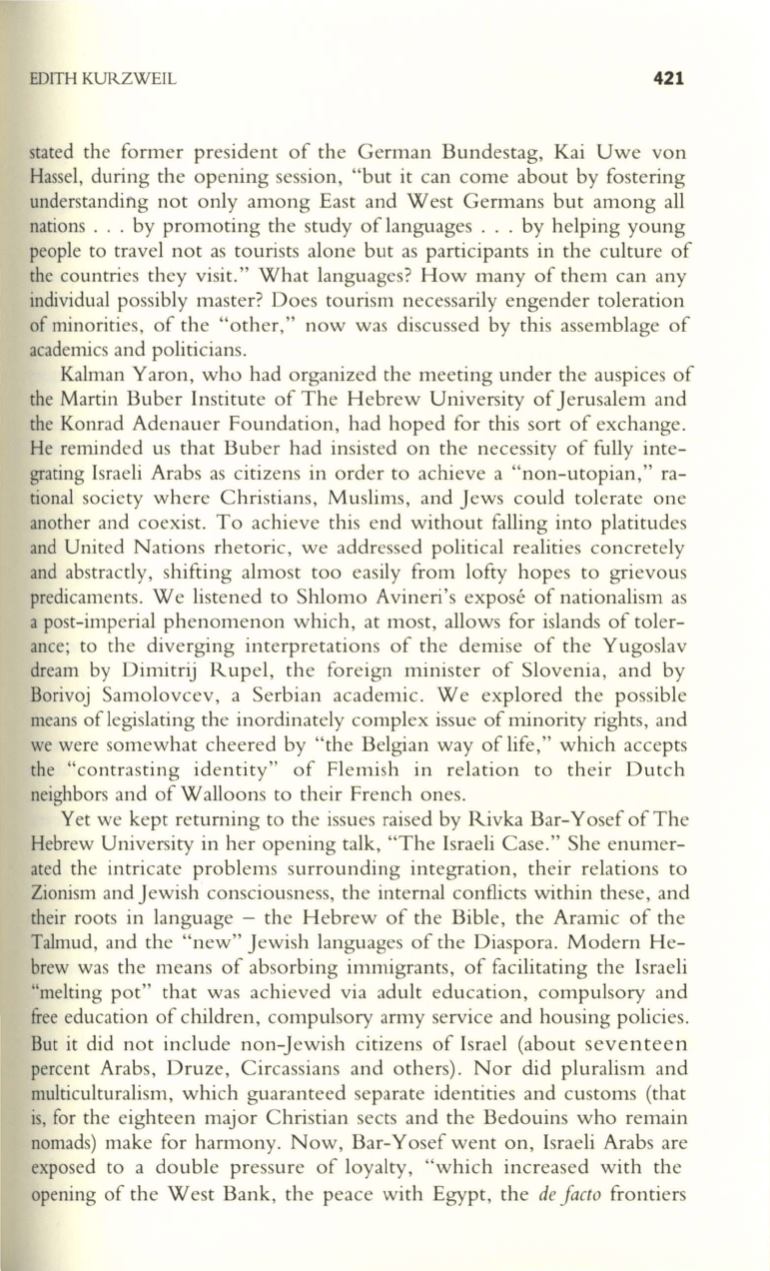
EDITH
KU1~ZWEIL
421
stated the former president of the German Bundestag, Kai Uwe von
Hassel, during the opening session, "but it can come about by fostering
understanding not only among East and West Germans but among all
nations ... by promoting the study of languages ... by helping young
people to travel not as tourists alone but as participants in the culture of
the countries they visit." What languages? How many of them can any
individual possibly master? Does tourism necessarily engender toleration
of minorities, of the "other," now was discussed by this assemblage of
academics and politicians.
Kalman Yaron, who had organized the meeting under the auspices of
the Martin Buber Institute of The Hebrew University of Jerusalem and
the Konrad Adenauer Foundation, had hoped for this sort of exchange.
He reminded us that Buber had insisted on the necessity of fully inte–
grating Israeli Arabs as citizens in order to achieve a "non-utopian," ra–
tional society where Christians, Muslims, and Jews could tolerate one
another and coexist. To achieve this end without falling into platitudes
and United Nations rhetoric, we addressed political realities concretely
and abstractly, shifting almost too easily from lofty hopes to grievous
predicaments. We listened to Shlomo Avineri's expose of nationalism as
a post-imperial phenomenon which, at most, allows for islands of toler–
ance;
to
the diverging interpretations of the demise of the Yugoslav
dream by Dimitrij Rupel, the foreign minister of Slovenia, and by
Borivoj Samolovcev, a Serbian academic. We explored the possible
means oflegislating the inordinately complex issue of minority rights, and
we were somewhat cheered by "the Belgian way of life," which accepts
the "contrasting identity" of Flemish in relation to their Dutch
neighbors and of Walloons to their French ones.
Yet we kept returning to the issues raised by Rivka Bar-Yosef of The
Hebrew University in her opening talk, "The Israeli Case." She enumer–
ated the intricate problems surrounding integration, their relations to
Zionism and Jewish consciousness, the internal conflicts within these, and
their roots in language - the Hebrew of the Bible, the Aramic of the
Talmud, and the "new" Jewish languages of the Diaspora. Modern He–
brew was the means of absorbing immigrants, of facilitating the Israeli
"melting pot" that was achieved via adult education, compulsory and
free education of children, compulsory army service and housing policies.
But it did not include non-Jewish citizens of Israel (about seventeen
percent Arabs, Druze, Circassians and others). Nor did pluralism and
multiculturalism, which guaranteed separate identities and customs (that
is, for the eighteen major Christian sects and the Bedouins who remain
nomads) make for harmony. Now, Bar-Yosef went on, Israeli Arabs are
exposed to a double pressure of loyalty, "which increased with the
opening of the West Bank, the peace with Egypt, the
de facto
frontiers


